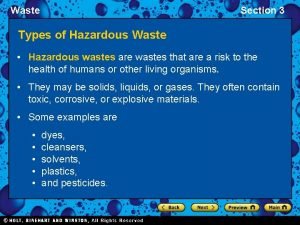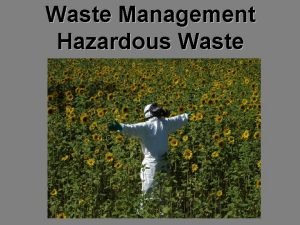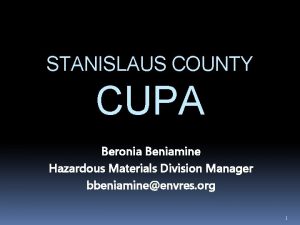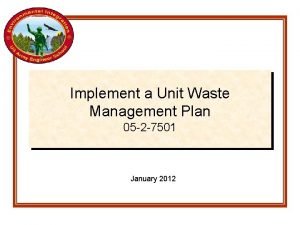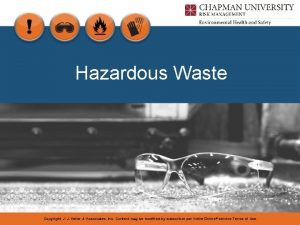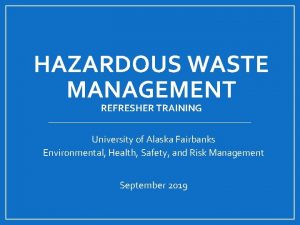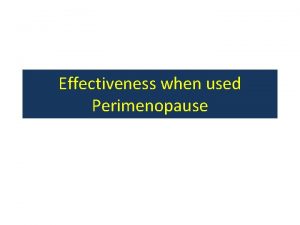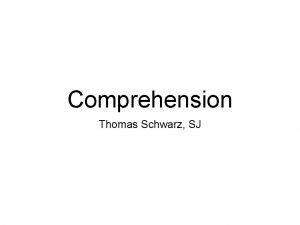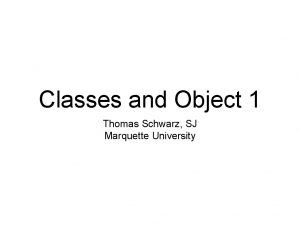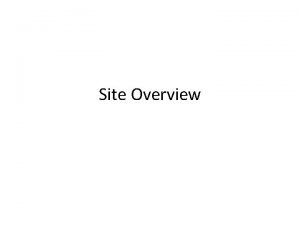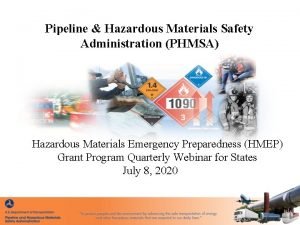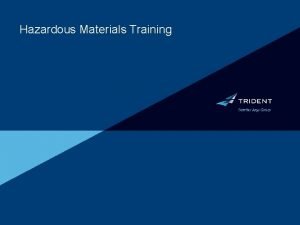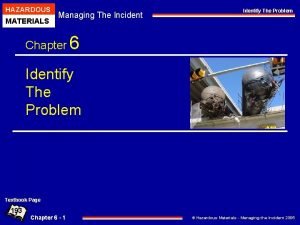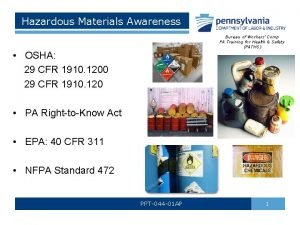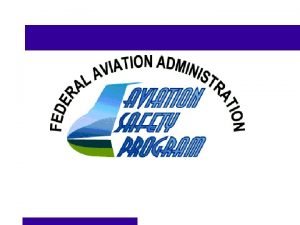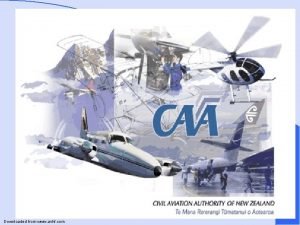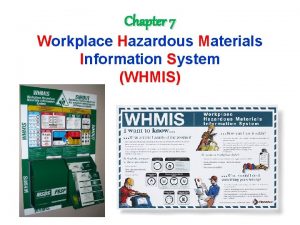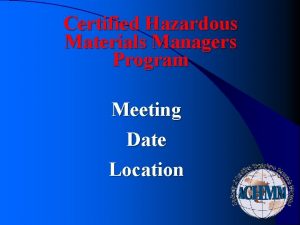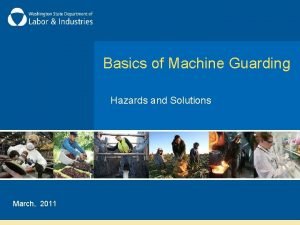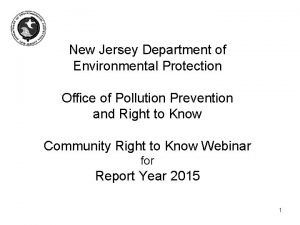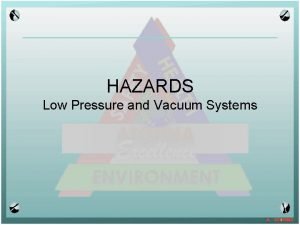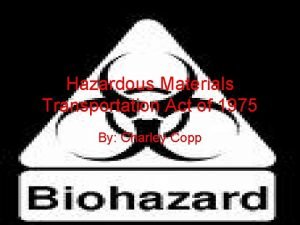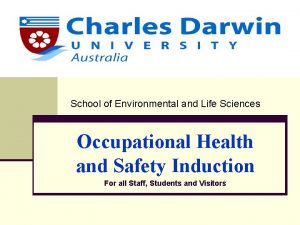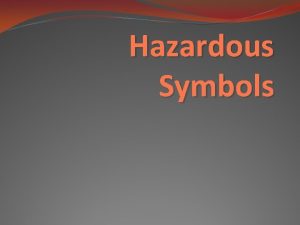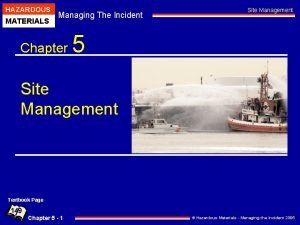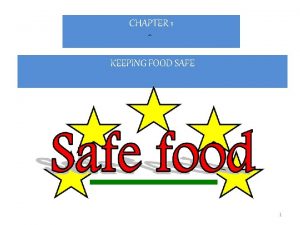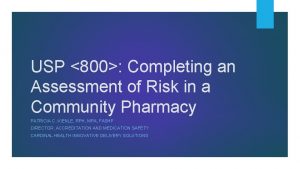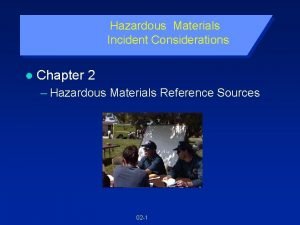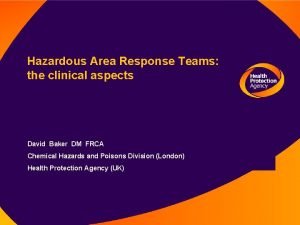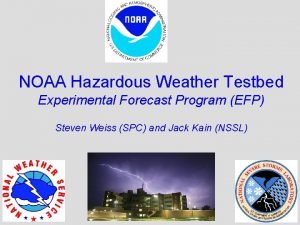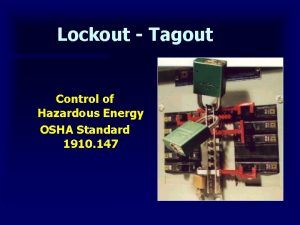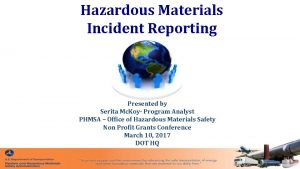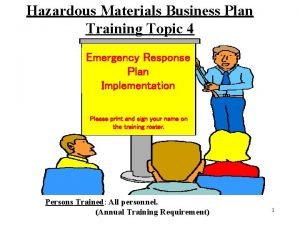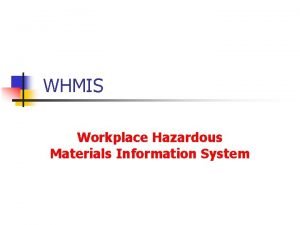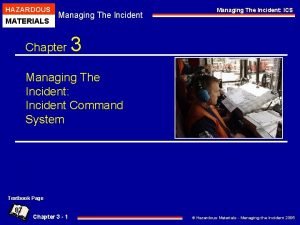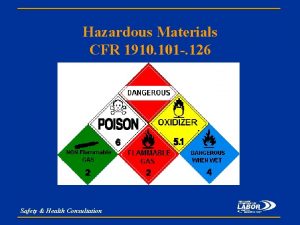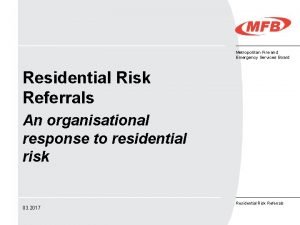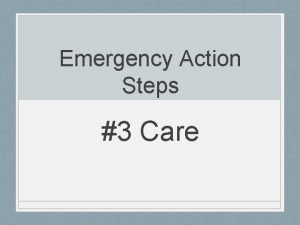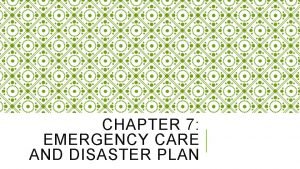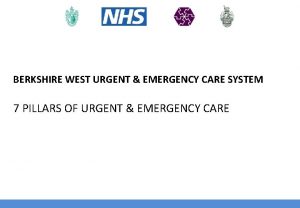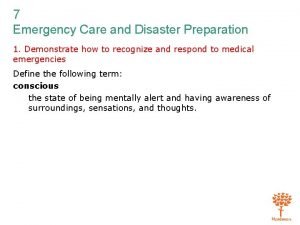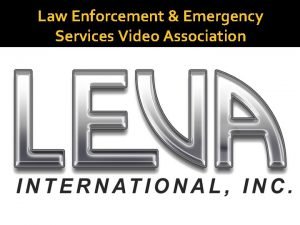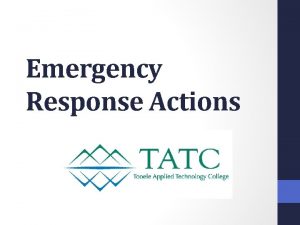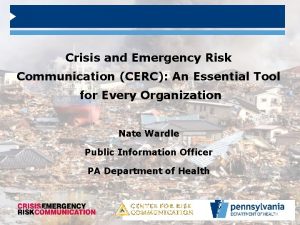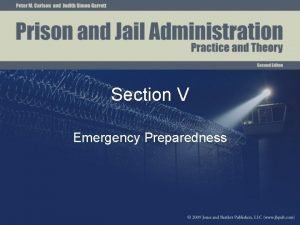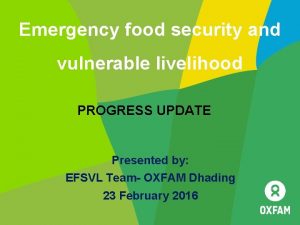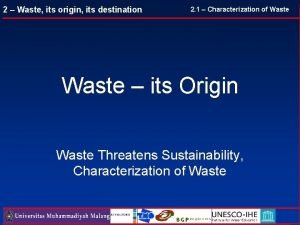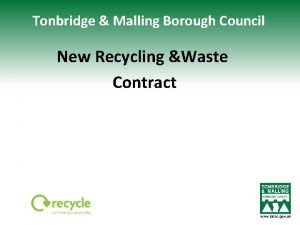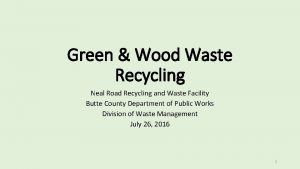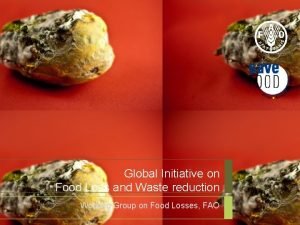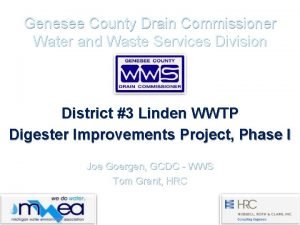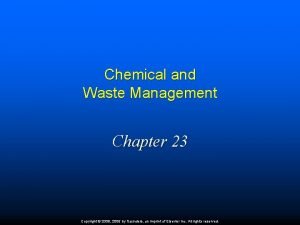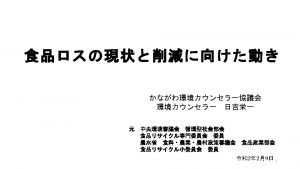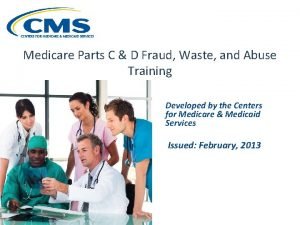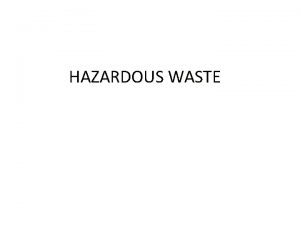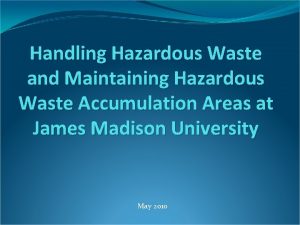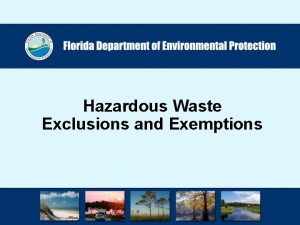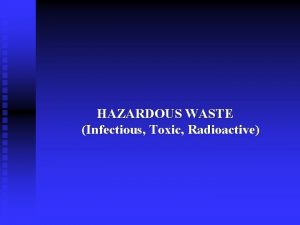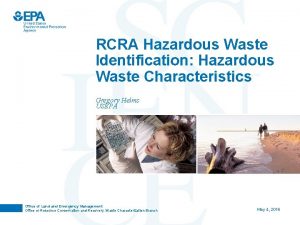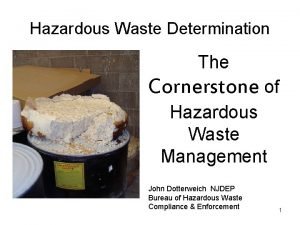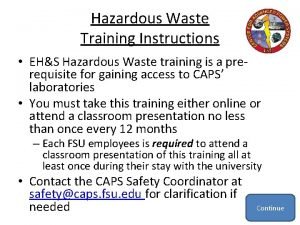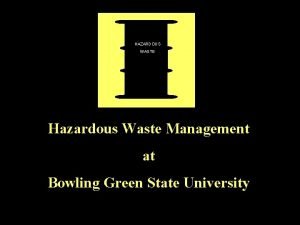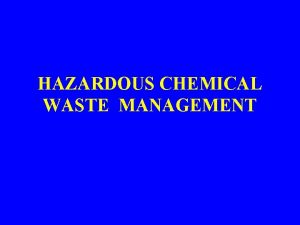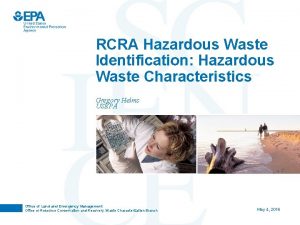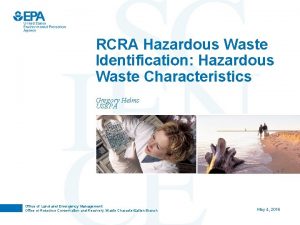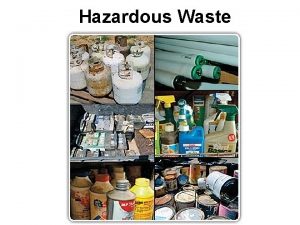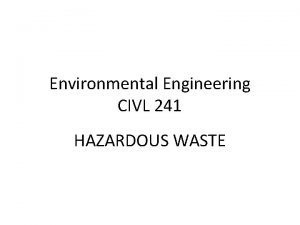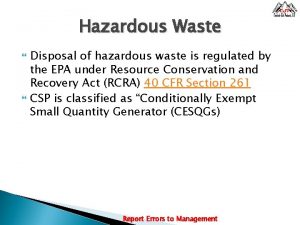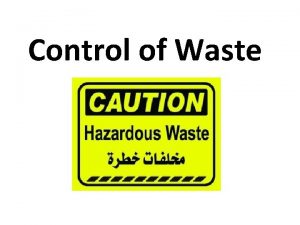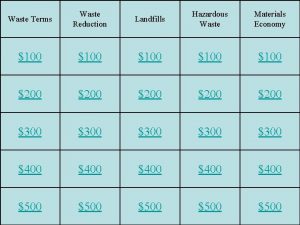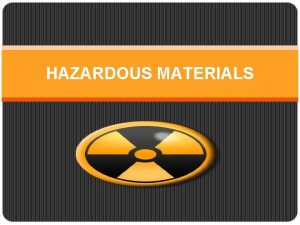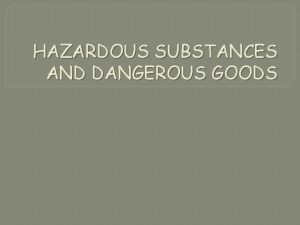Welcome to Marquette Universitys Hazardous Waste and Emergency






































































- Slides: 70

Welcome to Marquette University’s Hazardous Waste and Emergency Procedures Awareness Training NORTH AMERICA TECHNICAL SOLUTIONS www. Veolia. ES. com

Why am I here? • Handle or generate hazardous materials • Formal personnel training program is a requirement for large quantity generators (49 CFR 265. 16) • To be trained on the proper procedures of accumulating and storing hazardous materials to ensure compliance with the law • To prevent personal injury, property damage, or a major spill NORTH AMERICA www. Veolia. ES. com TECHNICAL SOLUTIONS www. Veolia. ES. com

Agenda • Marquette’s Classification & History • Hazardous Waste Characteristics • Recognizing Hazardous Materials • Handling Hazardous Materials & Proper Personal Protective Equipment • Satellite Accumulation Procedures • 90 -Day Storage Area Procedures • Spill Response, Clean-Up, Emergency Response and Preparedness NORTH AMERICA www. Veolia. ES. com TECHNICAL SOLUTIONS www. Veolia. ES. com

Acronyms • EPA = Environmental Protection Agency » Determines what is a hazardous waste • DOT = Department of Transportation » Regulates transportation of hazardous materials • RCRA = Resource Conservation & Recovery Act » Governs the disposal of solid and hazardous wastes • DNR = Department of Natural Resources » Governs over the generators of hazardous waste • OSHA = Occupational Safety and Health Administration » Regulates hazardous materials in the workplace • PPE = Personal Protective Equipment » Last line of defense against hazardous materials NORTH AMERICA www. Veolia. ES. com TECHNICAL SOLUTIONS www. Veolia. ES. com

Marquette’s History and Classification NORTH AMERICA TECHNICAL SOLUTIONS www. Veolia. ES. com

Marquette’s Hazardous Waste History • In 2010: – 8, 281 pounds of Hazardous Waste – 1, 204 pound of Non-Hazardous Waste • In 2009: – 20, 157 pounds of Hazardous Waste – 13, 413 pounds of Non-Hazardous Waste • In 2008: – 8, 623 pounds of Hazardous Waste – 2, 198 pounds of Non-Hazardous Waste • In 2007: – 12, 397 pounds of Hazardous Waste – 8, 018 pounds of Non-Hazardous Waste • Halogenated Solvents and Non-Halogenated Solvents • Veolia ES Technical Solutions disposes of materials • Small Quantity Generator to a Large Quantity Generator • Developing procedures and plans to comply with new regulations from this transition NORTH AMERICA www. Veolia. ES. com TECHNICAL SOLUTIONS www. Veolia. ES. com

Three Categories of Generators § Very Small Quantity Generator (VSQG) – < 220 lbs/month generation or < 2205 lbs total accumulation § Small Quantity Generator (SQG) – 220 - 2205 lbs/month generation or < 13, 230 lbs total accumulation § Large Quantity Generator (LQG) – > 2205 lbs generation/month or > 13, 230 lbs total accumulation § Acute Waste – >2. 2 lbs/month generation or > 2. 2 lbs accumulation at any time makes you a LQG NORTH AMERICA www. Veolia. ES. com TECHNICAL SOLUTIONS www. Veolia. ES. com

How much is that? 2200 lbs. (1000 kg) is about five 55 -gallon drums NORTH AMERICA www. Veolia. ES. com TECHNICAL SOLUTIONS www. Veolia. ES. com

Hazardous Waste Determination Characteristic versus Listed Wastes NORTH AMERICA TECHNICAL SOLUTIONS www. Veolia. ES. com

Hazardous Waste Determination • EPA Listed Wastes –P Listed: Unused acutely Hazardous Waste –U Listed: Unused non-acutely hazardous waste • Characteristic Wastes – – Ignitability Corrosivity Toxicity Reactivity –K Listed: Waste from Specific Sources –F Listed: Waste from Non. Specific Sources NORTH AMERICA www. Veolia. ES. com TECHNICAL SOLUTIONS www. Veolia. ES. com

Ignitable Wastes Flashpoint <140° F, or solids that easily catch fire. - Examples: acetone, xylene, and acetonitrile and other solvents Compressed flammable gases, such as propane Flammable solids, such as road flares or carbon. Ignitable materials are represented by a D 001 waste code. NORTH AMERICA www. Veolia. ES. com TECHNICAL SOLUTIONS www. Veolia. ES. com

Corrosive Wastes - p. H <2 or >12. 5 - Capable of corroding steel at a rate greater than 0. 25 inches per year. Examples: nitric acid, aqueous sodium hydroxide, hydrochloric acid. Potassium Tert-butoxide, a flammable solid Corrosive materials are represented by a D 002 waste code. NORTH AMERICA www. Veolia. ES. com TECHNICAL SOLUTIONS www. Veolia. ES. com

Reactive Wastes Materials that undergo violent change: - react violently with water or air - capable of detonation - create toxic gases when exposed to p. H extremes Examples: sodium metal, extremely dry picric acid, and organic peroxides. Reactive materials are represented by a D 003 waste code. NORTH AMERICA www. Veolia. ES. com TECHNICAL SOLUTIONS www. Veolia. ES. com

Toxic Wastes - Materials that are poisonous, harmful and potentially deadly Examples: lead acetate, mercuric chloride, benzene. The wastes are represented by codes from D 004 – D 043. These codes are specific to material types. For example: Mercury has a D 009 code, Benzene has D 018. NORTH AMERICA www. Veolia. ES. com TECHNICAL SOLUTIONS www. Veolia. ES. com

Examples of Toxic Contaminants Heavy Metals: arsenic, barium, cadmium, chromium, lead, mercury, selenium, silver Pesticides: Chlordane, 2, 4 -D, Endrin, Lindane, Heptachlor, Methoxychlor, Silvex (2, 4, 5 -TP), Toxaphene. Organics: benzene, carbon tetrachloride, chlorobenzene, chloroform, NORTH AMERICA www. Veolia. ES. com TECHNICAL SOLUTIONS Organics, continued: cresol, 1, 4 -dichlorobenzene, 1, 2 -dichloroethane, 1, 1 dichloroethylene, 2, 4 dinitrotoluene, hexachlorobenzene, hexachlorobutadiene, hexachloroethane, methyl ketone, nitrobenzene, pentachlorophenol, pyridine, tetrachloroethylene, trichloroethylene, 2, 4, 5 trichlrophenol, 2, 4, 6 trichlorophenol, vinyl chloride. www. Veolia. ES. com

Contact Dennis Daye (414) 288 -8411 if you have questions about the status of your waste. Hazardous Waste Management can be very confusing and we are here to help you! Aaron Walters, Veolia Environmental Services On campus Wednesday from 2 -4 PM NORTH AMERICA www. Veolia. ES. com TECHNICAL SOLUTIONS www. Veolia. ES. com

Recognizing Hazardous Materials NORTH AMERICA TECHNICAL SOLUTIONS www. Veolia. ES. com

Recognizing Hazardous Materials • Read Material Safety Data Sheets (MSDS) – A document provided by the manufacturer – Contain ingredients and lists the hazards of materials – Lists routes of exposure and proper PPE that should be worn when handling – Has spill response, disposal and other environmental information – Contains contacts if further information is needed M Material S Safety Data D Sheets S NORTH AMERICA www. Veolia. ES. com TECHNICAL SOLUTIONS www. Veolia. ES. com

http: //cispro. mu. edu/ NORTH AMERICA www. Veolia. ES. com TECHNICAL SOLUTIONS www. Veolia. ES. com

National Fire Protection Association (NFPA) Label • NFPA –Colors and numbers are used to communicate the potential hazards of a material. Flammability Hazard Health Hazard Reactivity Hazard Specific Hazards NORTH AMERICA www. Veolia. ES. com TECHNICAL SOLUTIONS www. Veolia. ES. com

NFPA: Health Hazard NORTH AMERICA www. Veolia. ES. com TECHNICAL SOLUTIONS www. Veolia. ES. com

NFPA: Flammability Hazard NORTH AMERICA www. Veolia. ES. com TECHNICAL SOLUTIONS www. Veolia. ES. com

NFPA: Reactivity Hazard NORTH AMERICA www. Veolia. ES. com TECHNICAL SOLUTIONS www. Veolia. ES. com

NFPA: Specific Hazards NORTH AMERICA www. Veolia. ES. com TECHNICAL SOLUTIONS www. Veolia. ES. com

Hazardous Materials Identification System(HMIS) Label Colors, numbers, and letters are used to communicate the potential hazards of a material as well as what kind of protective equipment should be worn. HEALTH 0 -4 FLAMMABILITY 0 -4 REACTIVITY 0 -4 PERSONAL PROTECTION letter NORTH AMERICA www. Veolia. ES. com TECHNICAL SOLUTIONS www. Veolia. ES. com

HMIS: Personal Protection G Safety glasses/gloves /vapor respirator A Safety glasses B Safety glasses/gloves H Goggles/gloves/apron/ vapor respirator C Safety glasses/gloves/apron I Safety glasses/gloves/dust and vapor respirator D Face shield/gloves/apron J E Safety glasses/gloves/dust respirator Goggles/gloves/apron/dust and vapor respirator K F Safety glasses/gloves/dust respirator/apron Airline hood or mask/gloves/protective coveralls/boots X Ask your supervisor NORTH AMERICA www. Veolia. ES. com TECHNICAL SOLUTIONS www. Veolia. ES. com

DOT Hazard Classes Department of Transportation (DOT) Hazard Class Diamonds and Placards –Containers and trucks are marked with diamonds to inform you of the material’s hazard class • Class 1 – Explosives • Class 2 – Gases • Class 3 – Flammable Liquids • Class 4 – Flammable Solids • Class 5 – Oxidizers and Organic Peroxides • Class 6 – Toxic Materials and Infectious Substances • Class 7 – Radioactive Materials • Class 8 – Corrosive • Class 9 – Miscellaneous Hazardous Materials NORTH AMERICA www. Veolia. ES. com TECHNICAL SOLUTIONS www. Veolia. ES. com

DOT Labels NORTH AMERICA www. Veolia. ES. com TECHNICAL SOLUTIONS www. Veolia. ES. com

Hazardous Material Handling and Proper Personal Protective Equipment NORTH AMERICA TECHNICAL SOLUTIONS www. Veolia. ES. com

Considerations when Handling Hazardous Materials • Use common sense! • Think before you act • Follow good housekeeping procedures – Clean-up after yourself • Always wear the proper PPE • Know the hazards of the materials you are working with! • Create and use chemical specific SOP’s (Safe Operating Procedures) NORTH AMERICA www. Veolia. ES. com TECHNICAL SOLUTIONS www. Veolia. ES. com

Material Handling and Proper PPE Controlling Hazards 1. Engineering Controls • Eliminate the hazard from the workplace 2. Administrative Controls • Limit worker contact with the hazard • Training/Procedures, Good Housekeeping 3. PPE • LAST RESORT NORTH AMERICA www. Veolia. ES. com TECHNICAL SOLUTIONS www. Veolia. ES. com

PPE = Last Resort • When PPE is the primary control measure, the hazard is still present in the environment • Failure of the PPE or improper usage can expose the worker to the full effect of the hazards present in the environment NORTH AMERICA www. Veolia. ES. com TECHNICAL SOLUTIONS www. Veolia. ES. com

Types of PPE • • Head Protection Eye/Face Protection Hearing Protection Foot Protection Respiratory Protection Hand Arm Protection Electrical Protective Devices Special Work Clothing NORTH AMERICA www. Veolia. ES. com TECHNICAL SOLUTIONS www. Veolia. ES. com

Considerations for PPE Selection: • The types of hazards you will be in contact with – Physical Hazards – Chemical Hazards • The specific chemicals you will be in contact with • The concentration of these chemicals • The length of time the PPE is to be worn • The durability of the PPE NORTH AMERICA www. Veolia. ES. com TECHNICAL SOLUTIONS www. Veolia. ES. com

PPE continued • PPE Limitations – – – Degradation Permeation/Breakthrough Penetration Tears/Rips Location • PPE Failure – Knowing how to recognize PPE failure is crucial since PPE is the last line of protection between you and the chemical – Limit contact time with the chemical/hazard and inspect and change PPE frequently NORTH AMERICA www. Veolia. ES. com TECHNICAL SOLUTIONS www. Veolia. ES. com

Satellite Accumulation Procedures NORTH AMERICA TECHNICAL SOLUTIONS www. Veolia. ES. com

Satellite Accumulation • “A generator may accumulate as much as 55 gallons of hazardous waste…in containers at or near any point of generation…which is under the control of the operator…” • Up to 1 quart of acutely hazardous waste (P-coded) can be collected in a satellite accumulation area • Your research labs, student labs or other rooms where materials are collected and accumulated are considered to be Satellite Accumulation Areas NORTH AMERICA www. Veolia. ES. com TECHNICAL SOLUTIONS www. Veolia. ES. com

Satellite Accumulation • Material name must be on label – NO CHEMICAL FORMULAS OR ABBREVIATIONS!!! • The container must have the words “hazardous waste” • Containers must remain closed when not adding waste • Must be leak-proof and in good condition • Containers must be compatible with contents – No corrosive materials in metal containers • Store liquid wastes in secondary containers – Must be able to hold 110% of the largest containers volume • Containers must be moved to storage location within 3 days after NORTH AMERICA being filled NORTH AMERICA www. Veolia. ES. com TECHNICAL SOLUTIONS www. Veolia. ES. com

Accumulation Start Date There are two (2) Regulations to follow: 1. Material can not be stored / accumulated in satellite accumulation area for more than one year. 2. Material can not be stored for more than 90 days in 90 -Day Storage Area. So, please put the date that you start accumulating material on the Hazardous Waste Tag. Before submitting for disposal, please cross-out and initial by the old NORTH AMERICA date and write in the current date NORTH AMERICA www. Veolia. ES. com TECHNICAL SOLUTIONS www. Veolia. ES. com

NORTH AMERICA Example of Inadequate Labeling NORTH AMERICA www. Veolia. ES. com TECHNICAL SOLUTIONS www. Veolia. ES. com

Example of Inadequate Labeling NORTH AMERICA www. Veolia. ES. com TECHNICAL SOLUTIONS www. Veolia. ES. com

Container Management • Attach label BEFORE adding waste • Container must be closed when not adding waste – Lids must be on – no funnels • Containers should be kept in their designated areas • Keep the outsides of containers free of waste • Do not use the top of the container as a storage shelf • Free access to containers must be maintained at all times! • Segregate Chemicals according to compatibility NORTH AMERICA www. Veolia. ES. com TECHNICAL SOLUTIONS www. Veolia. ES. com

MARQUETTE UNIVERSITY CHEMICAL COMPATIBILITY IN STORAGE Keep stored incompatible chemicals apart from each other. Keep incompatible chemicals apart by cabinet, drawer, shelving unit or shelf. For liquid and high hazard chemicals, secondary containers are effective tools to prevent reactions between incompatible chemicals. When storing reactive chemicals, secondary containment can prevent degradation and reactions that occur during storage. It is best to use secondary containers made of materials that are non-reactive (i. e. , polyethylene, polypropylene). Refer to Marquette’s Guidelines for Preventing Chemical Incompatibility Hazards. Hazard Storage Class Storage Type Examples Corrosives Cabinet Conc. Hydrochloric Acid (37%), Phosphoric Acid Less than concentrated: Sulfuric Acid, Nitric Acid Organic Acids Corrosives Cabinet Dichloroacetic Acid, EDTA (ethylenedinitrilo tetraacetic acid), Thimerosal Bases Corrosives Cabinet Ammonium Hydroxide, Calcium Oxide, Potassium Hydroxide, Sodium Hydroxide Oxidizing / Special Handling Inorganic Acids Corrosives Cabinet Bromine, Hydrofluoric Acid Cabinet labeled ‘Oxidizing / Special Handling Inorganic Acids’ Separate secondary containment for each (& label) Concentrated: Nitric Acid (70%) , Perchloric Acid (60%), Sulfuric Acid (96%) Oxidizers General Storage Cabinet labeled ‘Oxidizers’ Sodium Hypochlorite. The following are generally considered oxidizing substances: Peroxides, Perchlorates, Chlorates, Nitrites and less than concentrated Perchloric Acid. Toxics Designated Storage Cabinet Chloroform, Ethidium Bromide, Lead, Mercury Compounds, Potassium Cyanide, Phenol Flammables Flammable Storage Cabinet Only keep flammables in a flammable cabinet Acetone, Acetic Acid, Benzene, Ethyl Ether, Formaldehyde, Heptane, Hexane, Methanol, Pentane, Picric Acid, Toluene, Xylene General Storage Cabinet Double check NFPA Ratings to ensure general storage is appropriate Inorganic Acids Do not store acids and bases in same cabinet NONE Do not store acids and bases in same cabinet Cabinet labeled ‘Toxics’ , use secondary containment If there is an asterisk with the hazard storage class number (6*), the chemical is considered to be a particularly hazardous substance by Marquette University. A Standard Operating Procedure (SOP) is required for all particularly hazardous substances.

90 -Day Hazardous Waste Accumulation Area Procedures NORTH AMERICA TECHNICAL SOLUTIONS www. Veolia. ES. com

90 -Day Storage Area • Full, labeled and dated containers should be brought here for storage until the next waste pickup • Accumulation date is the date it is brought into storage area • Containers labeled and label is facing forwards • Containers must be clean, closed and intact • Incompatible materials must be segregated • There must be at least 3 feet of aisle space at all times • The area must be free of debris and spills These parameters above are federal & state regulations that must be followed or fines will be incurred!! NORTH AMERICA www. Veolia. ES. com TECHNICAL SOLUTIONS www. Veolia. ES. com

• The 90 -day storage area is inspected weekly to ensure that all of these regulations are complied with • Waste can only be stored in the accumulation area for 90 days • Any waste brought into the storage area must be marked on the waste generation form that is to be sent to Dennis NORTH AMERICA www. Veolia. ES. com TECHNICAL SOLUTIONS www. Veolia. ES. com

11/05/08 Olin Engineering 126 1 1 Jon Pipkorn Toluene Liquid 4 L 2 L Glass 1 NORTH AMERICA www. Veolia. ES. com TECHNICAL SOLUTIONS www. Veolia. ES. com

Your Responsibilities • You must fill out an inventory of material generated or discarded and send it to Dennis – State and Federal Regulations State: “The identity and location of all stored hazardous waste shall be known throughout the entire accumulation period. ” – To maintain documentation of hazardous waste that is currently being stored, in case of an emergency – Makes waste shipment easier – Aids in determining waste generation rate – Helps identify waste minimization opportunities • Please fill out sheet for materials to be disposed of on a regular basis • Inspect your work area to ensure proper procedures and practices are being followed NORTH AMERICA www. Veolia. ES. com TECHNICAL SOLUTIONS www. Veolia. ES. com

90 -Day Hazardous Waste Storage NORTH AMERICA www. Veolia. ES. com TECHNICAL SOLUTIONS www. Veolia. ES. com

What happens when an Acid and Oxidizer are mixed? NORTH AMERICA www. Veolia. ES. com TECHNICAL SOLUTIONS www. Veolia. ES. com

Spill Response, Clean-Up, and Emergency Response NORTH AMERICA TECHNICAL SOLUTIONS www. Veolia. ES. com

Please reference the Marquette University Emergency Procedures Guide and Contingency Plan for further details on what to do in case of an emergency. NORTH AMERICA www. Veolia. ES. com TECHNICAL SOLUTIONS www. Veolia. ES. com

Mercury Thermometer Exchange Program • Replace mercury thermometers with alcohol thermometers for FREE • The new alcohol thermometers will be paid for by EHS • Eliminates the possibility of mercury spills occurring • Please fill out the “Mercury Thermometer Exchange Request” Form and send to Dennis Daye NORTH AMERICA www. Veolia. ES. com TECHNICAL SOLUTIONS www. Veolia. ES. com

Causes of a Spill Causes of chemical spills are as follows: • Inappropriate handling techniques; • Inappropriate storage containers; • Damaged storage containers; • Uncontrolled access to chemical storage; • Lack of chemical-related training; and • Lack of supervision. NORTH AMERICA www. Veolia. ES. com TECHNICAL SOLUTIONS www. Veolia. ES. com

Dangers of Chemical Spills • Slip, trip, fall hazard • Contamination of other materials • Risk of Fire • Possible Release to the Environment • Routes of Exposure to Hazardous Materials – – Inhalation Injection Ingestion Absorption NORTH AMERICA www. Veolia. ES. com TECHNICAL SOLUTIONS www. Veolia. ES. com

Dangerous to you… Why chemicals are dangerous? • Chemicals can cause: - Burns - Adverse health effects - Permanent disabilities - Death • Sometimes problems occur immediately (Acute effect) • Others may happen after years of exposure (Chronic effect). NORTH AMERICA www. Veolia. ES. com TECHNICAL SOLUTIONS www. Veolia. ES. com

Spill Prevention Planning • Only buy and store amount of material needed • Buy the least hazardous materials possible • Use non-hazardous materials when possible • Minimize traffic in the area • Store liquid wastes in secondary containers • Regularly inspect containers to ensure their integrity • Be aware of evacuation routes and emergency equipment NORTH AMERICA www. Veolia. ES. com TECHNICAL SOLUTIONS www. Veolia. ES. com

Managing A Spill What type and size of spills am I capable of managing? You should only be cleaning up small spills (less than 1 gallon) of known materials that you work with on a regular basis after you have had attended a hands-on training session given by the EHS department. Small spill clean-up kits are located in the 90 -day storage area and in “all” laboratories. Notify the Public Safety Department (x 8 -1911) for larger spills, or spills containing reactive or highly toxic materials. Public Safety will notify the proper authorities. NORTH AMERICA www. Veolia. ES. com TECHNICAL SOLUTIONS www. Veolia. ES. com

Spill Kits These spill kits contain everything you need to properly manage a small spill in your labs. These are available for $48 each. Please contact Dennis Daye to place an order and purchase. NORTH AMERICA www. Veolia. ES. com TECHNICAL SOLUTIONS www. Veolia. ES. com

Managing A Spill… • In the event of a chemical spill, first decide if you are trained, knowledgeable and equipped to handle the incident. • Prepare a plan of action (e. g. waiting for help, attend to injured, shutting off the valve, turn off ignition sources in presence of flammables if safe to do so) • Immediately evacuate the lab and notify Public Safety if there is a possibility of an acute respiratory hazard present or if you need assistance to clean up the spill. – Never proceed to clean up a spill if you do not know the hazards associated with the chemical or if you are unsure of how to clean up the spill. • If anyone is injured or contaminated, immediately notify Public Safety and begin decontamination measures or first aid, if trained. • Make sure to wear the proper PPE. – Apron, Gloves, Goggles, etc. NORTH AMERICA www. Veolia. ES. com TECHNICAL SOLUTIONS www. Veolia. ES. com

Managing A Spill… Contain the spill (Stopping the source and stopping the spread) • stopping the source includes: – – Closing a valve; Shutting down a pump to stop flow; Putting “bandage” around a leaking hose; Positioning of leaking container. • stopping the spread includes: – Building a barrier around the spill; – Make a flow channel; – Use of absorbent or spill pads; NORTH AMERICA www. Veolia. ES. com TECHNICAL SOLUTIONS www. Veolia. ES. com

Managing A Spill… • Absorbent should be distributed over the entire spill area, working from the outside, circling to the inside. – This stops the spread of the spilled chemical. • When spilled materials have been absorbed, use brush and scoop to place materials in an appropriate container (bag is provided in spill kits). – Dispose of any contaminated PPE used during cleanup. • Complete hazardous waste sticker, identifying the material as Spill Debris involving XYZ Chemical, and affix onto the container. Arrange for pick-up by EH&S Dept. as soon as possible. NORTH AMERICA www. Veolia. ES. com TECHNICAL SOLUTIONS www. Veolia. ES. com

Flammable Liquids • When managing a spill of a flammable liquid… – Turn off all sources of ignition – Lay the chemical spill pads over the spill • Pads are designed to suppress flammable vapors – Allow pads to completely absorb the liquid – Place the pads in plastic disposal bag – Wipe up any remaining liquid with paper towel – Dispose of the paper towel in plastic bag – Seal bag and attach a completed hazardous waste sticker NORTH AMERICA www. Veolia. ES. com TECHNICAL SOLUTIONS www. Veolia. ES. com

After the spill… • Remember that absorbed materials have the same properties and hazards as the original spilled materials. • Safely dispose all disposable coveralls, gloves and respirators. • Decontaminate all non-disposable items (brooms, shovels, thongs, protective clothing) using a mild detergent and water. • Arrange for pick up by EH&S Dept. as soon as possible. NORTH AMERICA www. Veolia. ES. com TECHNICAL SOLUTIONS www. Veolia. ES. com

After the spill… • Review what happened to prevent reoccurrence. • No matter how small the spill, keep a record of what happened. • Make sure that supplies (e. g. first aid, spill control kit) are replaced immediately. (Contact EH&S) ONLY HANDLE SPILLS OF A GALLON OR LESS OF A KNOWN MATERIAL. FOR LARGE SPILLS OR REACTIVE MATERIALS CONTACT PUBLIC SAFETY (x 8 -1911). NORTH AMERICA www. Veolia. ES. com TECHNICAL SOLUTIONS www. Veolia. ES. com

What to do when an emergency occurs… • TAKE CARE OF THE SAFETY OF YOURSELF AND OTHERS! • Activate the building’s fire alarm system. • If you have bodily contact with material: – immediately remove any contaminated clothing – flush the area with copious amounts of water • Call Public Safety at 288 -1911 – – Identify yourself and why you are calling the exact location and nature of the emergency any injuries of symptoms involved all hazardous materials involved (if known) NORTH AMERICA www. Veolia. ES. com TECHNICAL SOLUTIONS www. Veolia. ES. com

What to do when an emergency occurs… • Evacuate building to a safe distance (at least 100 feet) • leave clear access for emergency personnel • Keep all persons exposed in the same area. They should not leave until they are cleared by proper authorities. • If you have time to do so safely – – Close, but do not lock, doors behind you to isolate the area Turn off, unplug, or remove potential sources of ignition Contain the spill material with berms or other means Post a sign to warn others not to enter the area YOUR SAFETY AND THE SAFETY OF OTHERS SHOULD BE YOUR TOP PRIORITY! NORTH AMERICA www. Veolia. ES. com TECHNICAL SOLUTIONS www. Veolia. ES. com

This is a general awareness training. You are not trained as an emergency responder and should not attempt to manage emergencies. Emergency agencies such as the Fire Department, Police Department and Haz Mat Response Teams will be responsible for situations other than easily contained spills or incidental situations. ALWAYS CALL 288 -1911 ON CAMPUS TO REPORT AN EMERGENCY NORTH AMERICA www. Veolia. ES. com TECHNICAL SOLUTIONS www. Veolia. ES. com

Questions or Suggestions? Feel free to contact Dennis Daye (414) 288 -8411 or Aaron Walters with questions, concerns, or suggestions. NORTH AMERICA TECHNICAL SOLUTIONS www. Veolia. ES. com

Thank you for participating in Hazardous Waste Generator Requirements Training NORTH AMERICA TECHNICAL SOLUTIONS www. Veolia. ES. com
 Boston universitys
Boston universitys Solid and hazardous waste
Solid and hazardous waste Section 3 hazardous waste answers
Section 3 hazardous waste answers Definition of biomedical waste management
Definition of biomedical waste management Hazardous waste apes
Hazardous waste apes Sample of hazardous waste
Sample of hazardous waste Stanislaus county hazardous materials division
Stanislaus county hazardous materials division Waste management references
Waste management references Hazardous waste transportation
Hazardous waste transportation Alaska hazmat training
Alaska hazmat training Accomplishments of louis xiv
Accomplishments of louis xiv Marquette nfp training
Marquette nfp training Marquette nfp perimenopause
Marquette nfp perimenopause Sjcontents
Sjcontents Thomas schwarz marquette university
Thomas schwarz marquette university Red wings marquette prison
Red wings marquette prison Marquette web design
Marquette web design Pipeline and hazardous materials administration
Pipeline and hazardous materials administration Wise men three clever are we
Wise men three clever are we Aviation hazardous attitudes
Aviation hazardous attitudes Hazardous material table
Hazardous material table Hazardous materials table
Hazardous materials table Us military marking system for hazardous materials
Us military marking system for hazardous materials Pa-psfa-hazardous materials awareness
Pa-psfa-hazardous materials awareness Five hazardous attitudes
Five hazardous attitudes Aviation hazardous attitudes
Aviation hazardous attitudes What shape and color are the whmis 2015 symbols
What shape and color are the whmis 2015 symbols Isachmm
Isachmm Transverse motion machine
Transverse motion machine Nj crtk environmental hazardous substances
Nj crtk environmental hazardous substances Low pressure hazardous vacuum switch
Low pressure hazardous vacuum switch Hazardous materials transportation act of 1975
Hazardous materials transportation act of 1975 Hazardous area training darwin
Hazardous area training darwin Hazardous symbols
Hazardous symbols Hazardous materials managing the incident
Hazardous materials managing the incident Potentially hazardous food is usually moist
Potentially hazardous food is usually moist Hazardous drug api
Hazardous drug api On july 18 2001 a train carrying hazardous chemicals
On july 18 2001 a train carrying hazardous chemicals Hazardous materials reference books
Hazardous materials reference books Hazardous area response teams
Hazardous area response teams Hazardous movement asl
Hazardous movement asl Hazardous weather testbed
Hazardous weather testbed Tagout
Tagout Hazardous materials incident report
Hazardous materials incident report Hazardous materials business plan
Hazardous materials business plan Hazardous chemicals
Hazardous chemicals Hazardous materials managing the incident
Hazardous materials managing the incident Osha psm 1910
Osha psm 1910 Metropolitan fire and emergency services board
Metropolitan fire and emergency services board Emergency care and first aid ppt
Emergency care and first aid ppt What are the emergency action steps?
What are the emergency action steps? Emergency care and disaster preparation chapter 7
Emergency care and disaster preparation chapter 7 Chapter 36 emergency preparedness and protective practices
Chapter 36 emergency preparedness and protective practices 7 pillars of urgent and emergency care
7 pillars of urgent and emergency care Emergency care first aid and disasters
Emergency care first aid and disasters Emergency care and disaster preparation
Emergency care and disaster preparation Law enforcement video association
Law enforcement video association Pps emergency signals and actions
Pps emergency signals and actions Crisis and emergency risk communication
Crisis and emergency risk communication Chapter 36 emergency preparedness and protective practices
Chapter 36 emergency preparedness and protective practices Emergency food security and vulnerable livelihoods
Emergency food security and vulnerable livelihoods Computer waste and mistakes
Computer waste and mistakes Waste and its types
Waste and its types Tonbridge and malling brown bin
Tonbridge and malling brown bin Neal road landfill fees
Neal road landfill fees Global initiative on food loss and waste reduction
Global initiative on food loss and waste reduction Genesee waste services
Genesee waste services Chemical and waste management chapter 23
Chemical and waste management chapter 23 Food loss and waste
Food loss and waste How is waste and nutrients transported in a cnidarian
How is waste and nutrients transported in a cnidarian Fraud waste and abuse training answers
Fraud waste and abuse training answers


